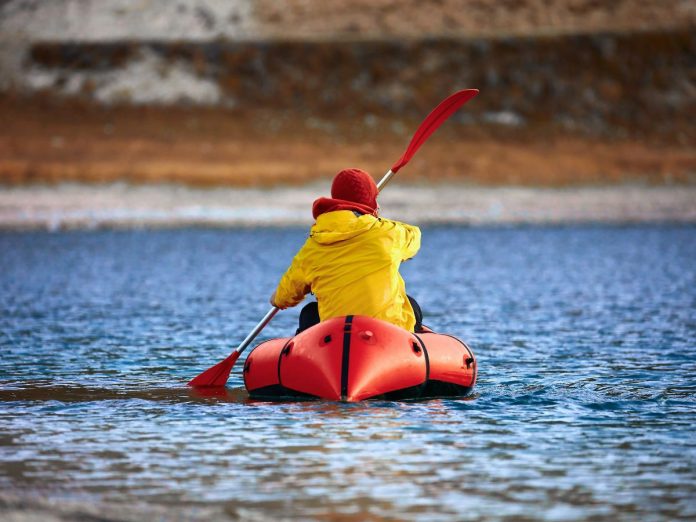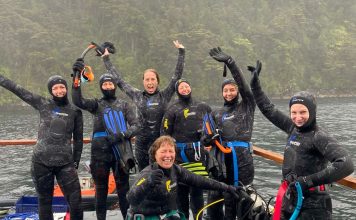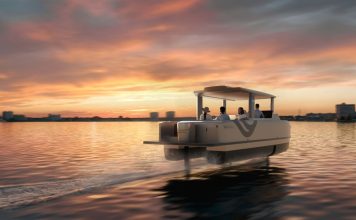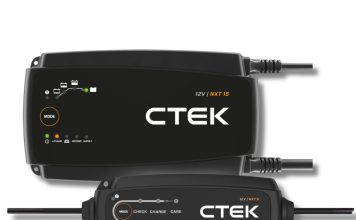If you’ve ever stood at the end of a tramp and thought, “I could float that,” you already understand packrafting. These small, inflatable boats weigh only a few kilos, roll up to the size of a sleeping bag, and can carry you, your gear, and even a bike across water that once marked the end of the trail.The idea’s simple: hike in, inflate, paddle out. From alpine valleys to forested gorges, packrafting blends tramping, kayaking, and pure exploration in a way that feels tailor-made for New Zealand.
Made for our backyard
Our country’s rivers tumble from mountains to sea through public land stitched with huts and tracks. It’s easy to plan a weekend loop that combines walking and paddling; and with warmer weather arriving, flows are dropping into their best range.
In the South Island, classics like the Rees and Dart offer jaw-dropping alpine runs, while Fiordland and the West Coast deliver clear pools and technical boulder gardens. The Clarence remains the long-distance favourite, running from the St James Range to the Kaikōura coast.
Up north, the Whanganui River Journey is the perfect starting point, a gentle three-to-five-day float through deep bush and pā sites. For more action, the Mohaka, Rangitīkei, and Waioeka mix remote wilderness with lively rapids—all within reach for a long weekend.

Always, safety first
Know your river
Check the weather, know the flow, and travel with friends. Even familiar rivers can change overnight, and the line between a relaxed drift and a whitewater rescue is often just a few cumecs (cubic metres per second (m³/s)).
Flow data from regional councils shows real-time levels in cumecs. For most packrafts, 5–10 cumecs means friendly water; above 20 cumecs it’s serious business.
As always, plan with a dropping forecast, avoid rivers in flood, and never underestimate how quickly cold water can sap your energy. In many catchments, snowmelt in late spring raises flows even under blue skies.
Skills
As packrafting is whitewater, every paddler should know how to swim defensively, read a river, and perform a basic rescue.
A personal flotation device (PFD), helmet, throw rope, and communication beacon are essential. For overnight trips, carry a repair kit and a spare inflation bag.
The Packrafting Association of New Zealand (PRANZ) and several guiding companies in Wānaka, Queenstown, and Taupō run short training courses that cover river reading, group safety, and navigation. It’s the best starting point for anyone new to moving water.
If you’re new to packrafting, start with something gentle, maybe a float through the Whanganui valleys or a weekend in the Nelson Lakes, then work up to more technical runs as your confidence builds.
Packrafts
Construction and materials
Most modern packrafts use TPU-laminated nylon, welded for airtight seams. Floors and contact points are built from heavier fabric to resist abrasion, and most inflate with a lightweight air bag instead of a pump. Optional upgrades typically include self-bailing floors, spray decks, and internal cargo zips for storing gear inside the tubes, handy on multi-day trips where space is tight.
Choosing your packraft
Packrafts come in several styles, from minimalist tramping companions to reinforced whitewater machines. The right choice depends on where you plan to paddle and how much weight you’re willing to carry.
Flatwater / Touring
Typically wide hulled, stable bottomed, and with high load capacity, these are great for families and first-timers who want to take on lakes, estuaries, and easier rivers like the Whanganui or Mohaka. • Size: 2.4–2.7 m • Weight: 3.5–5 kg
A good example of a Flatwater / Touring packraft in New Zealand would be something like the Alpacka Flatwater or Kokopelli Rogue-Lite, both of which are popular here.
Ultralight / Expedition
Featuring open designs, thin TPU fabric, and minimal fittings making them light and ideal for remote terrain where you’ll walk more than paddle. They are what you need to link tramping routes, alpine crossings, or for lightweight missions. • Size: 2.1–2.4 m • Weight: under 4 kg.
Popular ultralight packrafts for alpine tramping in NZ include the Alpacka Scout, Kokopelli Rogue-Lite, and MRS Microraft—light, durable boats ideal for short crossings and braided rivers in South Island backcountry terrain.
On trips like the Rees–Dart Track (Otago) or a Hopkins–Huxley valley crossing (Canterbury), trampers often carry an ultralight packraft to safely cross wide, cold braided rivers near the end of the tramp or link valleys that would otherwise require a long detour. In these situations, the raft might only be paddled for a few kilometres, just enough to float gear, cross safely, or connect two remote catchments.
Whitewater / Technical
For adventurers who want a little more excitement, these packrafts feature reinforced floors, self-bailing decks, thigh straps and are built to handle grade II–III rivers rivers like the Waioeka or upper Clarence but only when levels are right. • Size: 2.3–2.6 m • Weight: 4–6 kg
Popular whitewater packrafts in NZ include the Alpacka Gnarwhal, Kokopelli Recon, and MRS Alligator; durable, self-bailing boats built for Grade II–III rivers like the Ashley Gorge, Waioeka, and upper Clarence.
A prime New Zealand example of a Whitewater packrafting trip is the Ashley River / Rakahuri Gorge in North Canterbury. At moderate flows (around 5–10 cumecs), it’s a fun Grade II–III run with short rapids, boulder gardens, and plenty of eddies for scouting — perfect for skilled packrafters with self-rescue training.
Tandem / Load-carrying
Great for two paddlers or solo missions with hunting gear, or the up-country hunt of the ‘day’, these packrafts feature extended hulls, modular seating, and big tubes for added buoyancy. • Size: 2.8–3.2 m • Weight: 5–7 kg
Popular tandem packrafts in NZ include the Alpacka Oryx and Kokopelli Twain, stable, high-capacity boats suited for two paddlers or heavy gear on long trips such as the Whanganui River Journey or Clarence River expeditions.
A popular New Zealand route for tandem or load-carrying packrafts is the Clarence River in Marlborough. Stretching about 200 km from the St James Range to the Kaikōura coast, it’s a Grade II–III multi-day journey through remote high-country valleys and gorges.
Tandem packrafts are ideal here because they can carry two paddlers plus full camping gear for a week-long trip, handling braided sections, mild rapids, and long stretches of flat water efficiently. It’s one of Aotearoa’s great wilderness rivers: scenic, committing, and perfectly suited to self-supported tandem expeditions.
Bikerafting
Bikerafting is real and steadily growing in New Zealand, especially among the same community of trampers, hunters, and bikepackers who already explore the backcountry under their own steam. A packraft used by bikerafters features a reinforced bow, tie-downs and an open deck. • Weight: around 5 kg
A popular bikerafting packraft used in New Zealand is the Kokopelli Recon or Alpacka Caribou—both reinforced, self-bailing models with lash points designed to secure a mountain bike to the bow.
They’re commonly seen on Timber Trail–Whanganui River adventures, where riders bike part of the trail, then float down the Whanganui before pedalling out. These packrafts are tough enough for Grade I–II rivers and have the volume and stability needed to carry both rider and bike through New Zealand’s remote bush and river systems.
Light touch, big reward
Packrafting leaves almost nothing behind: no motor, no noise, and no tracks to scar the bush. Clean and dry your gear between catchments, respect access points, and you’ll keep these waterways wild for the next trip.
THIS SUMMER, THROW A RAFT IN YOUR PACK AND SEE WHERE NEW ZEALAND’S RIVERS CAN TAKE YOU. WALK IN, PADDLE OUT, AND REDISCOVER THE BACKCOUNTRY FROM THE WATERLINE.
















